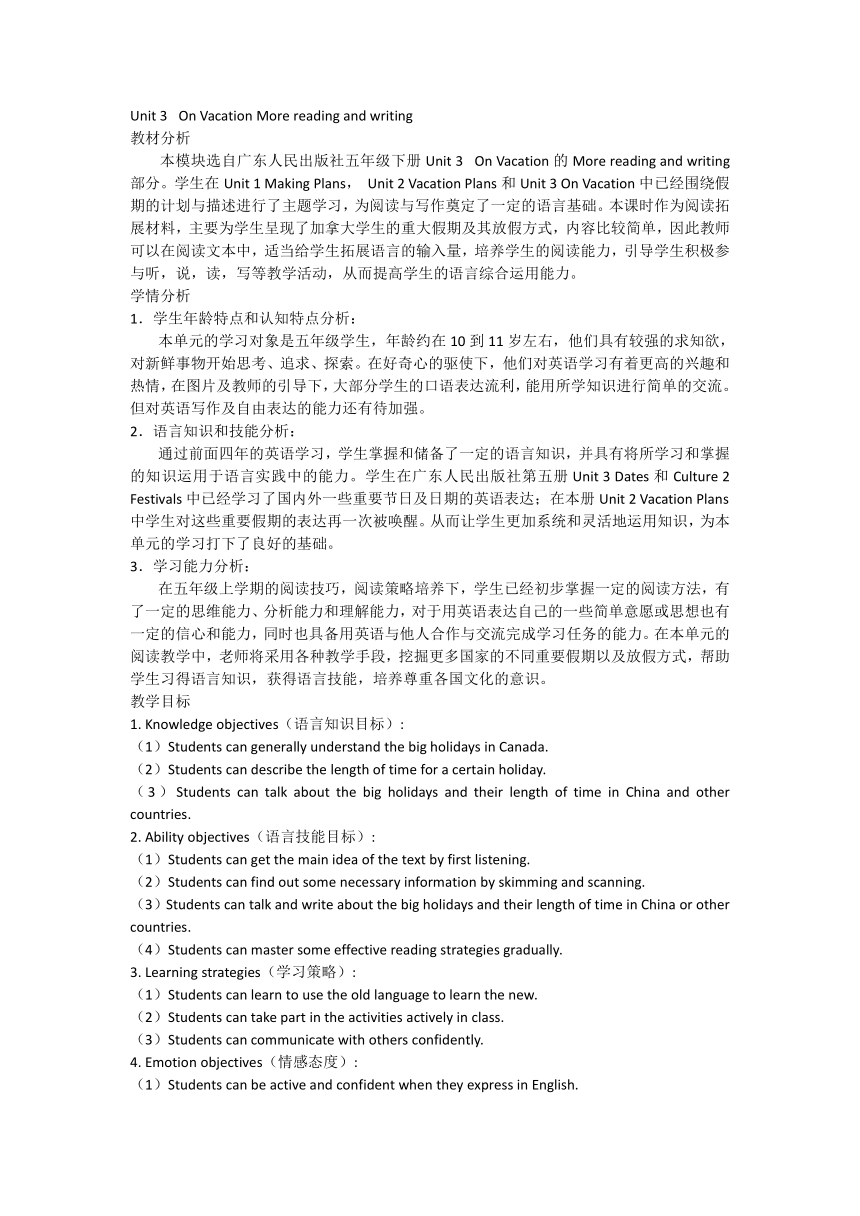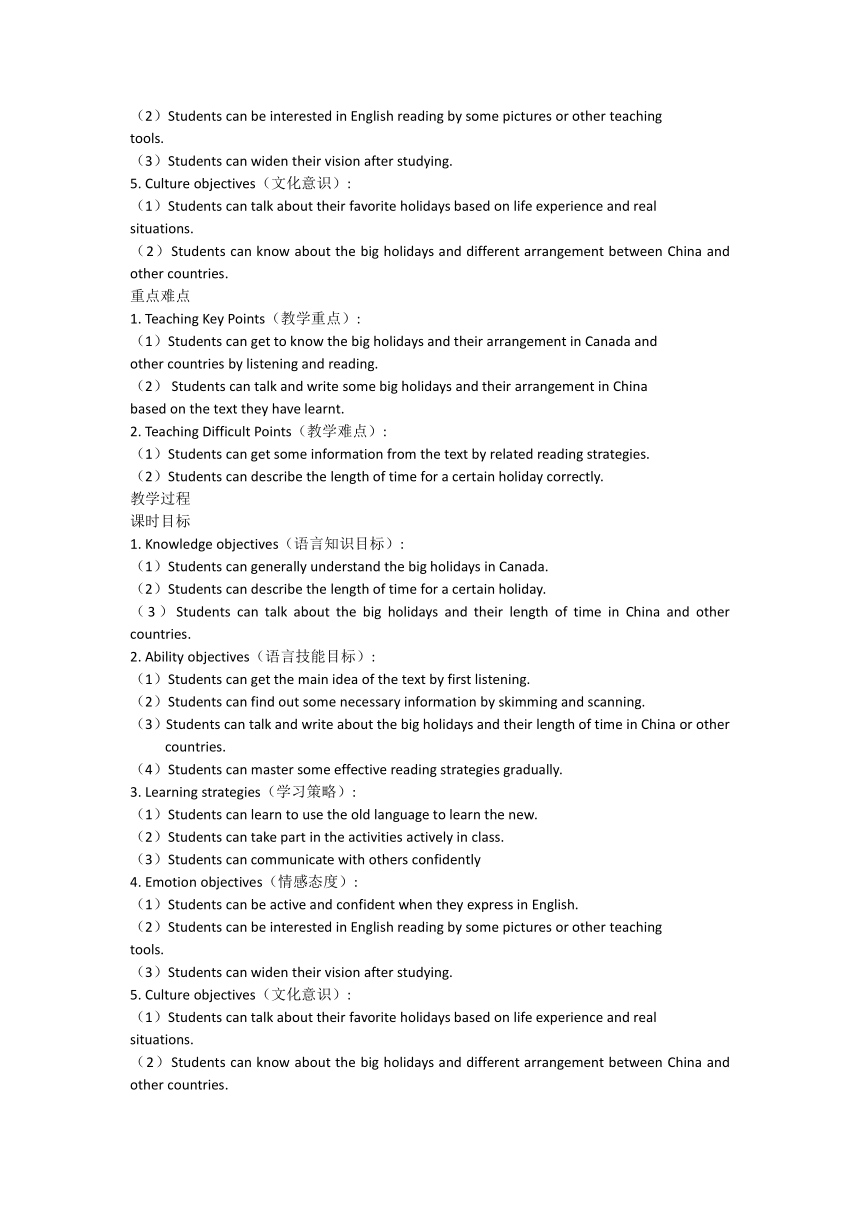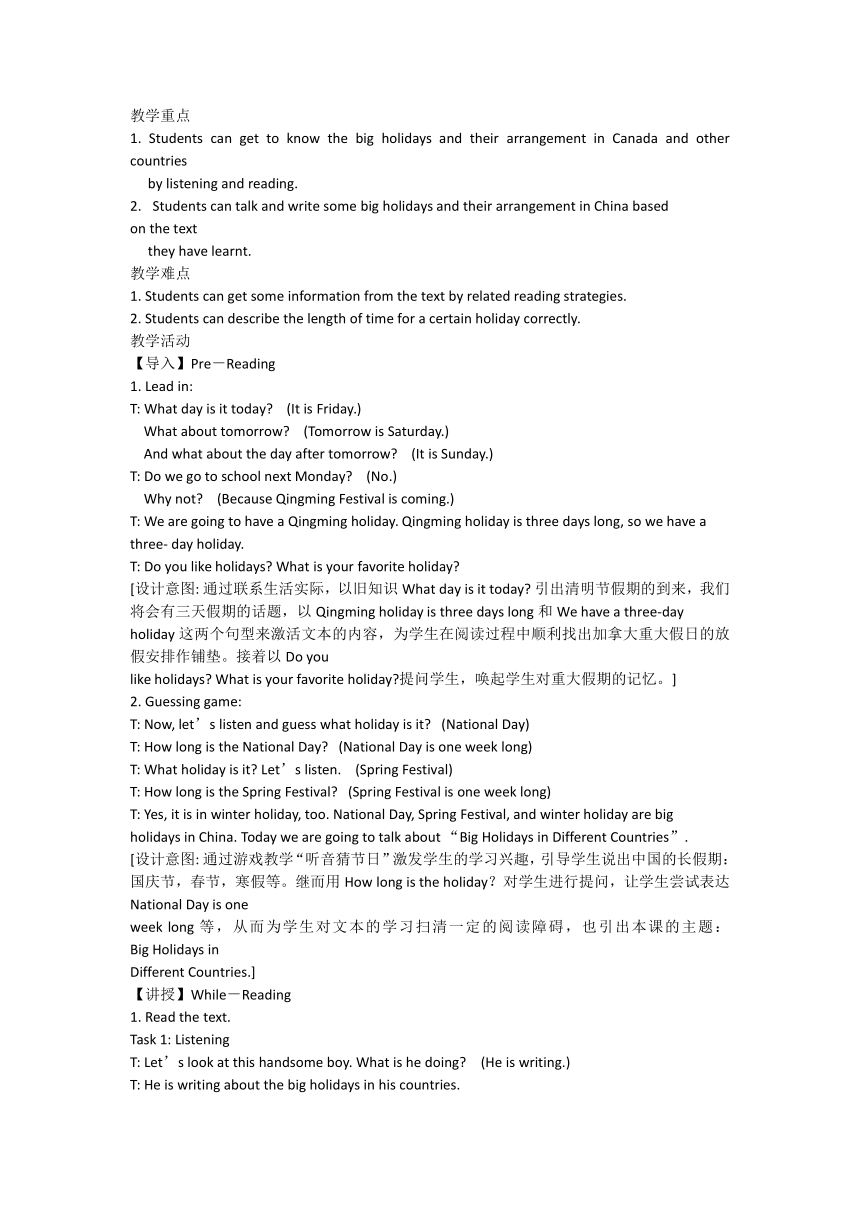Unit 3 On Vacation More reading and writing教学设计
文档属性
| 名称 | Unit 3 On Vacation More reading and writing教学设计 |  | |
| 格式 | docx | ||
| 文件大小 | 16.0KB | ||
| 资源类型 | 教案 | ||
| 版本资源 | 广东版 | ||
| 科目 | 英语 | ||
| 更新时间 | 2023-09-11 19:27:25 | ||
图片预览



文档简介
Unit 3 On Vacation More reading and writing
教材分析
本模块选自广东人民出版社五年级下册Unit 3 On Vacation的More reading and writing部分。学生在Unit 1 Making Plans, Unit 2 Vacation Plans和Unit 3 On Vacation中已经围绕假期的计划与描述进行了主题学习,为阅读与写作奠定了一定的语言基础。本课时作为阅读拓展材料,主要为学生呈现了加拿大学生的重大假期及其放假方式,内容比较简单,因此教师可以在阅读文本中,适当给学生拓展语言的输入量,培养学生的阅读能力,引导学生积极参与听,说,读,写等教学活动,从而提高学生的语言综合运用能力。
学情分析
1.学生年龄特点和认知特点分析:
本单元的学习对象是五年级学生,年龄约在10到11岁左右,他们具有较强的求知欲,对新鲜事物开始思考、追求、探索。在好奇心的驱使下,他们对英语学习有着更高的兴趣和热情,在图片及教师的引导下,大部分学生的口语表达流利,能用所学知识进行简单的交流。但对英语写作及自由表达的能力还有待加强。
2.语言知识和技能分析:
通过前面四年的英语学习,学生掌握和储备了一定的语言知识,并具有将所学习和掌握的知识运用于语言实践中的能力。学生在广东人民出版社第五册Unit 3 Dates和Culture 2 Festivals中已经学习了国内外一些重要节日及日期的英语表达;在本册Unit 2 Vacation Plans中学生对这些重要假期的表达再一次被唤醒。从而让学生更加系统和灵活地运用知识,为本单元的学习打下了良好的基础。
3.学习能力分析:
在五年级上学期的阅读技巧,阅读策略培养下,学生已经初步掌握一定的阅读方法,有了一定的思维能力、分析能力和理解能力,对于用英语表达自己的一些简单意愿或思想也有一定的信心和能力,同时也具备用英语与他人合作与交流完成学习任务的能力。在本单元的阅读教学中,老师将采用各种教学手段,挖掘更多国家的不同重要假期以及放假方式,帮助学生习得语言知识,获得语言技能,培养尊重各国文化的意识。
教学目标
1. Knowledge objectives(语言知识目标):
(1)Students can generally understand the big holidays in Canada.
(2)Students can describe the length of time for a certain holiday.
(3)Students can talk about the big holidays and their length of time in China and other countries.
2. Ability objectives(语言技能目标):
(1)Students can get the main idea of the text by first listening.
(2)Students can find out some necessary information by skimming and scanning.
(3)Students can talk and write about the big holidays and their length of time in China or other countries.
(4)Students can master some effective reading strategies gradually.
3. Learning strategies(学习策略):
(1)Students can learn to use the old language to learn the new.
(2)Students can take part in the activities actively in class.
(3)Students can communicate with others confidently.
4. Emotion objectives(情感态度):
(1)Students can be active and confident when they express in English.
(2)Students can be interested in English reading by some pictures or other teaching
tools.
(3)Students can widen their vision after studying.
5. Culture objectives(文化意识):
(1)Students can talk about their favorite holidays based on life experience and real
situations.
(2)Students can know about the big holidays and different arrangement between China and other countries.
重点难点
1. Teaching Key Points(教学重点):
(1)Students can get to know the big holidays and their arrangement in Canada and
other countries by listening and reading.
(2) Students can talk and write some big holidays and their arrangement in China
based on the text they have learnt.
2. Teaching Difficult Points(教学难点):
(1)Students can get some information from the text by related reading strategies.
(2)Students can describe the length of time for a certain holiday correctly.
教学过程
课时目标
1. Knowledge objectives(语言知识目标):
(1)Students can generally understand the big holidays in Canada.
(2)Students can describe the length of time for a certain holiday.
(3)Students can talk about the big holidays and their length of time in China and other countries.
2. Ability objectives(语言技能目标):
(1)Students can get the main idea of the text by first listening.
(2)Students can find out some necessary information by skimming and scanning.
(3)Students can talk and write about the big holidays and their length of time in China or other
countries.
(4)Students can master some effective reading strategies gradually.
3. Learning strategies(学习策略):
(1)Students can learn to use the old language to learn the new.
(2)Students can take part in the activities actively in class.
(3)Students can communicate with others confidently
4. Emotion objectives(情感态度):
(1)Students can be active and confident when they express in English.
(2)Students can be interested in English reading by some pictures or other teaching
tools.
(3)Students can widen their vision after studying.
5. Culture objectives(文化意识):
(1)Students can talk about their favorite holidays based on life experience and real
situations.
(2)Students can know about the big holidays and different arrangement between China and other countries.
教学重点
1. Students can get to know the big holidays and their arrangement in Canada and other countries
by listening and reading.
2. Students can talk and write some big holidays and their arrangement in China based
on the text
they have learnt.
教学难点
1. Students can get some information from the text by related reading strategies.
2. Students can describe the length of time for a certain holiday correctly.
教学活动
【导入】Pre-Reading
1. Lead in:
T: What day is it today (It is Friday.)
What about tomorrow (Tomorrow is Saturday.)
And what about the day after tomorrow (It is Sunday.)
T: Do we go to school next Monday (No.)
Why not (Because Qingming Festival is coming.)
T: We are going to have a Qingming holiday. Qingming holiday is three days long, so we have a
three- day holiday.
T: Do you like holidays What is your favorite holiday
[设计意图: 通过联系生活实际,以旧知识What day is it today 引出清明节假期的到来,我们将会有三天假期的话题,以Qingming holiday is three days long和We have a three-day
holiday这两个句型来激活文本的内容,为学生在阅读过程中顺利找出加拿大重大假日的放假安排作铺垫。接着以Do you
like holidays What is your favorite holiday 提问学生,唤起学生对重大假期的记忆。]
2. Guessing game:
T: Now, let’s listen and guess what holiday is it (National Day)
T: How long is the National Day (National Day is one week long)
T: What holiday is it Let’s listen. (Spring Festival)
T: How long is the Spring Festival (Spring Festival is one week long)
T: Yes, it is in winter holiday, too. National Day, Spring Festival, and winter holiday are big
holidays in China. Today we are going to talk about “Big Holidays in Different Countries”.
[设计意图: 通过游戏教学“听音猜节日”激发学生的学习兴趣,引导学生说出中国的长假期:国庆节,春节,寒假等。继而用How long is the holiday?对学生进行提问,让学生尝试表达National Day is one
week long等,从而为学生对文本的学习扫清一定的阅读障碍,也引出本课的主题:Big Holidays in
Different Countries.]
【讲授】While-Reading
1. Read the text.
Task 1: Listening
T: Let’s look at this handsome boy. What is he doing (He is writing.)
T: He is writing about the big holidays in his countries.
Let’s listen, where is he from, Canada Or America (Canada)
T: Do you want to visit Canada Let’s go!
(Show some pictures of Canada with music)
[设计意图:通过任务一:不带文本听,训练学生的听力,让学生通过听,抓住“Canada”一词,从而把握文本的大意,知道这是描述加拿大重大假期的阅读材料。当学生抓住这一大意后,适时向学生配乐插图介绍加拿大 的著名建筑景点,让学生不知不觉沉浸其中,从而激发学生的阅读兴趣。]
Task 2: Skimming
T: What are the big holidays in Canada Let’s read the text quickly, and circle the
answers.
(Give some reading tips to the Ss before they get into the reading, lead them to
find out the answers
according to the key word “big holidays”)
[设计意图:通过任务二:跳读,让学生快速找到关键信息:the big holidays in Canada。在学生自主阅读前,给出相关的阅读提示,训练学生抓住关键词,快速阅读文本,寻找关键信息的阅读技巧。]
Task 3: Scanning
T: How long are these big holidays in Canada Let’s read the text carefully, and
underline the answers.
(Make some examples to explain the meaning of “How long” to students, so that they can find out the answers easily.)
[设计意图:通过任务三:寻读,先指导学生看清楚问题,理解how long的意思,再指导学生快速阅读,查找与时间长度有关的信息。从而培养学生在文本中快速寻找信息的阅读能力。]
Task 4: Information-arrange
T: Now, let’s arrange the information together.
(Lead the Ss to pay attention to the first word of each sentence, understand the
meaning of questions. Then read the text again, and finish the exercise.)
[设计意图:通过任务四:信息整理,检验学生在前两个阅读任务中学习的阅读能力,放手让学生通过跳读,寻读两种阅读技巧,独立完成课文后面 的阅读练习。]
Task 5: Listen and repeat
T: Let’s listen and repeat it.
(Ask Ss to repeat the text, imitate the tone of the language, and have an overall
review of the text.
[设计意图:通过任务五:跟读,让学生在模仿中学习地道的语音语调,并在读的过程中,再一次回顾文本的内容。]
Task 6: Talk in pairs
T: From this text, we know that Jeff is from…
He has three big holidays. What are they And how long are they Let’s talk in pairs.
[设计意图:通过任务六:同桌交流,让学生再一次互相检验对文本的理解,对重要句型Their summer holiday is 9 weeks long进行巩固,从而突破重点难点。也为接下来引出英国重要假期及其放假方式的教学环节作准备。]
2. Read the chart.
(1)Read the chart, and answer some questions.
T: Look at this handsome boy. Where is he from
What are the big holidays in his countries
And how long are they Please read the chart.
(After reading for some time, let some Ss answer the questions, meanwhile, the teacher writes down some information of the UK on blackboard.)
[设计意图:在前面的环节中,学生在老师的引导下,已初步掌握跳读,寻读的阅读技巧。因此这环节的设计意图是:老师放手让学生运用相应的阅读技巧,自己读图表,完成阅读任务。]
(2)Read the chart, and complete the sentences.
T: Now, let’s read the chart again, and complete the sentences by yourselves.
(Let the Ss read the chart by themselves, then check the answers.)
[设计意图:在前面的环节中,学生在老师的引导下,已初步掌握跳读,寻读的阅读技巧。因此这环节的设计意图是:老师放手让学生运用相应的阅读技巧,自己读图表,完成课后练习。]
3. Sum up
(The teacher leads the students to sum up the big holidays and time arrangement of
Canada and the UK with blackboard-writing.)
[设计意图:学生在老师的引导下,小结加拿大和英国的重大假期及其放假安排,这既让学生对文本进行回顾,也让老师检测学生的阅读所得]
【活动】Post-Reading
1. Enjoy the big holidays in other countries.
(Show some video about big holidays in Japan and Australia. Lead the Ss to compare
the culture
differences between China and other countries.)
[设计意图:通过视频介绍,给学生拓展更多国家的重大假期及其放假方式,同时进行文化渗透,让学生了解不同国家有不同的假期,而且放假的时间长短也各异。]
2. Talk about big holidays in China.
T: Do you know other big holidays in China
What are they And how long are these holidays
(After Ss’ talking, ask Ss to fill in the blanks with new learnt expression.)
[设计意图:本教学环节属于输出环节,通过前面的大量语言输入,学生回归到现在所处的中国,用这节课所学到的We have summer holiday, summer holiday is 8 weeks long等表达方式进行口头汇报后,写下来。]
3. Design the holiday arrangement in China.
T: If you are one of the members in State Department, You can decide the holiday
arrangement in
China, how will you design
[设计意图:本环节以“假如你是国务院的成员,由你来确定中国的重大假期及其放假方式,你会怎样设计?”这一贴近学生,并让学生感兴趣的话题,让学生再一次强化本文涉及的语言表达。]
【作业】Homework
1. Design the holidays and talk with your partners.
(设计放假安排,并与同学分享)
2. Surf the Internet for more big holidays in different countries.
(上网搜集更多其他国家的重大假期)
教材分析
本模块选自广东人民出版社五年级下册Unit 3 On Vacation的More reading and writing部分。学生在Unit 1 Making Plans, Unit 2 Vacation Plans和Unit 3 On Vacation中已经围绕假期的计划与描述进行了主题学习,为阅读与写作奠定了一定的语言基础。本课时作为阅读拓展材料,主要为学生呈现了加拿大学生的重大假期及其放假方式,内容比较简单,因此教师可以在阅读文本中,适当给学生拓展语言的输入量,培养学生的阅读能力,引导学生积极参与听,说,读,写等教学活动,从而提高学生的语言综合运用能力。
学情分析
1.学生年龄特点和认知特点分析:
本单元的学习对象是五年级学生,年龄约在10到11岁左右,他们具有较强的求知欲,对新鲜事物开始思考、追求、探索。在好奇心的驱使下,他们对英语学习有着更高的兴趣和热情,在图片及教师的引导下,大部分学生的口语表达流利,能用所学知识进行简单的交流。但对英语写作及自由表达的能力还有待加强。
2.语言知识和技能分析:
通过前面四年的英语学习,学生掌握和储备了一定的语言知识,并具有将所学习和掌握的知识运用于语言实践中的能力。学生在广东人民出版社第五册Unit 3 Dates和Culture 2 Festivals中已经学习了国内外一些重要节日及日期的英语表达;在本册Unit 2 Vacation Plans中学生对这些重要假期的表达再一次被唤醒。从而让学生更加系统和灵活地运用知识,为本单元的学习打下了良好的基础。
3.学习能力分析:
在五年级上学期的阅读技巧,阅读策略培养下,学生已经初步掌握一定的阅读方法,有了一定的思维能力、分析能力和理解能力,对于用英语表达自己的一些简单意愿或思想也有一定的信心和能力,同时也具备用英语与他人合作与交流完成学习任务的能力。在本单元的阅读教学中,老师将采用各种教学手段,挖掘更多国家的不同重要假期以及放假方式,帮助学生习得语言知识,获得语言技能,培养尊重各国文化的意识。
教学目标
1. Knowledge objectives(语言知识目标):
(1)Students can generally understand the big holidays in Canada.
(2)Students can describe the length of time for a certain holiday.
(3)Students can talk about the big holidays and their length of time in China and other countries.
2. Ability objectives(语言技能目标):
(1)Students can get the main idea of the text by first listening.
(2)Students can find out some necessary information by skimming and scanning.
(3)Students can talk and write about the big holidays and their length of time in China or other countries.
(4)Students can master some effective reading strategies gradually.
3. Learning strategies(学习策略):
(1)Students can learn to use the old language to learn the new.
(2)Students can take part in the activities actively in class.
(3)Students can communicate with others confidently.
4. Emotion objectives(情感态度):
(1)Students can be active and confident when they express in English.
(2)Students can be interested in English reading by some pictures or other teaching
tools.
(3)Students can widen their vision after studying.
5. Culture objectives(文化意识):
(1)Students can talk about their favorite holidays based on life experience and real
situations.
(2)Students can know about the big holidays and different arrangement between China and other countries.
重点难点
1. Teaching Key Points(教学重点):
(1)Students can get to know the big holidays and their arrangement in Canada and
other countries by listening and reading.
(2) Students can talk and write some big holidays and their arrangement in China
based on the text they have learnt.
2. Teaching Difficult Points(教学难点):
(1)Students can get some information from the text by related reading strategies.
(2)Students can describe the length of time for a certain holiday correctly.
教学过程
课时目标
1. Knowledge objectives(语言知识目标):
(1)Students can generally understand the big holidays in Canada.
(2)Students can describe the length of time for a certain holiday.
(3)Students can talk about the big holidays and their length of time in China and other countries.
2. Ability objectives(语言技能目标):
(1)Students can get the main idea of the text by first listening.
(2)Students can find out some necessary information by skimming and scanning.
(3)Students can talk and write about the big holidays and their length of time in China or other
countries.
(4)Students can master some effective reading strategies gradually.
3. Learning strategies(学习策略):
(1)Students can learn to use the old language to learn the new.
(2)Students can take part in the activities actively in class.
(3)Students can communicate with others confidently
4. Emotion objectives(情感态度):
(1)Students can be active and confident when they express in English.
(2)Students can be interested in English reading by some pictures or other teaching
tools.
(3)Students can widen their vision after studying.
5. Culture objectives(文化意识):
(1)Students can talk about their favorite holidays based on life experience and real
situations.
(2)Students can know about the big holidays and different arrangement between China and other countries.
教学重点
1. Students can get to know the big holidays and their arrangement in Canada and other countries
by listening and reading.
2. Students can talk and write some big holidays and their arrangement in China based
on the text
they have learnt.
教学难点
1. Students can get some information from the text by related reading strategies.
2. Students can describe the length of time for a certain holiday correctly.
教学活动
【导入】Pre-Reading
1. Lead in:
T: What day is it today (It is Friday.)
What about tomorrow (Tomorrow is Saturday.)
And what about the day after tomorrow (It is Sunday.)
T: Do we go to school next Monday (No.)
Why not (Because Qingming Festival is coming.)
T: We are going to have a Qingming holiday. Qingming holiday is three days long, so we have a
three- day holiday.
T: Do you like holidays What is your favorite holiday
[设计意图: 通过联系生活实际,以旧知识What day is it today 引出清明节假期的到来,我们将会有三天假期的话题,以Qingming holiday is three days long和We have a three-day
holiday这两个句型来激活文本的内容,为学生在阅读过程中顺利找出加拿大重大假日的放假安排作铺垫。接着以Do you
like holidays What is your favorite holiday 提问学生,唤起学生对重大假期的记忆。]
2. Guessing game:
T: Now, let’s listen and guess what holiday is it (National Day)
T: How long is the National Day (National Day is one week long)
T: What holiday is it Let’s listen. (Spring Festival)
T: How long is the Spring Festival (Spring Festival is one week long)
T: Yes, it is in winter holiday, too. National Day, Spring Festival, and winter holiday are big
holidays in China. Today we are going to talk about “Big Holidays in Different Countries”.
[设计意图: 通过游戏教学“听音猜节日”激发学生的学习兴趣,引导学生说出中国的长假期:国庆节,春节,寒假等。继而用How long is the holiday?对学生进行提问,让学生尝试表达National Day is one
week long等,从而为学生对文本的学习扫清一定的阅读障碍,也引出本课的主题:Big Holidays in
Different Countries.]
【讲授】While-Reading
1. Read the text.
Task 1: Listening
T: Let’s look at this handsome boy. What is he doing (He is writing.)
T: He is writing about the big holidays in his countries.
Let’s listen, where is he from, Canada Or America (Canada)
T: Do you want to visit Canada Let’s go!
(Show some pictures of Canada with music)
[设计意图:通过任务一:不带文本听,训练学生的听力,让学生通过听,抓住“Canada”一词,从而把握文本的大意,知道这是描述加拿大重大假期的阅读材料。当学生抓住这一大意后,适时向学生配乐插图介绍加拿大 的著名建筑景点,让学生不知不觉沉浸其中,从而激发学生的阅读兴趣。]
Task 2: Skimming
T: What are the big holidays in Canada Let’s read the text quickly, and circle the
answers.
(Give some reading tips to the Ss before they get into the reading, lead them to
find out the answers
according to the key word “big holidays”)
[设计意图:通过任务二:跳读,让学生快速找到关键信息:the big holidays in Canada。在学生自主阅读前,给出相关的阅读提示,训练学生抓住关键词,快速阅读文本,寻找关键信息的阅读技巧。]
Task 3: Scanning
T: How long are these big holidays in Canada Let’s read the text carefully, and
underline the answers.
(Make some examples to explain the meaning of “How long” to students, so that they can find out the answers easily.)
[设计意图:通过任务三:寻读,先指导学生看清楚问题,理解how long的意思,再指导学生快速阅读,查找与时间长度有关的信息。从而培养学生在文本中快速寻找信息的阅读能力。]
Task 4: Information-arrange
T: Now, let’s arrange the information together.
(Lead the Ss to pay attention to the first word of each sentence, understand the
meaning of questions. Then read the text again, and finish the exercise.)
[设计意图:通过任务四:信息整理,检验学生在前两个阅读任务中学习的阅读能力,放手让学生通过跳读,寻读两种阅读技巧,独立完成课文后面 的阅读练习。]
Task 5: Listen and repeat
T: Let’s listen and repeat it.
(Ask Ss to repeat the text, imitate the tone of the language, and have an overall
review of the text.
[设计意图:通过任务五:跟读,让学生在模仿中学习地道的语音语调,并在读的过程中,再一次回顾文本的内容。]
Task 6: Talk in pairs
T: From this text, we know that Jeff is from…
He has three big holidays. What are they And how long are they Let’s talk in pairs.
[设计意图:通过任务六:同桌交流,让学生再一次互相检验对文本的理解,对重要句型Their summer holiday is 9 weeks long进行巩固,从而突破重点难点。也为接下来引出英国重要假期及其放假方式的教学环节作准备。]
2. Read the chart.
(1)Read the chart, and answer some questions.
T: Look at this handsome boy. Where is he from
What are the big holidays in his countries
And how long are they Please read the chart.
(After reading for some time, let some Ss answer the questions, meanwhile, the teacher writes down some information of the UK on blackboard.)
[设计意图:在前面的环节中,学生在老师的引导下,已初步掌握跳读,寻读的阅读技巧。因此这环节的设计意图是:老师放手让学生运用相应的阅读技巧,自己读图表,完成阅读任务。]
(2)Read the chart, and complete the sentences.
T: Now, let’s read the chart again, and complete the sentences by yourselves.
(Let the Ss read the chart by themselves, then check the answers.)
[设计意图:在前面的环节中,学生在老师的引导下,已初步掌握跳读,寻读的阅读技巧。因此这环节的设计意图是:老师放手让学生运用相应的阅读技巧,自己读图表,完成课后练习。]
3. Sum up
(The teacher leads the students to sum up the big holidays and time arrangement of
Canada and the UK with blackboard-writing.)
[设计意图:学生在老师的引导下,小结加拿大和英国的重大假期及其放假安排,这既让学生对文本进行回顾,也让老师检测学生的阅读所得]
【活动】Post-Reading
1. Enjoy the big holidays in other countries.
(Show some video about big holidays in Japan and Australia. Lead the Ss to compare
the culture
differences between China and other countries.)
[设计意图:通过视频介绍,给学生拓展更多国家的重大假期及其放假方式,同时进行文化渗透,让学生了解不同国家有不同的假期,而且放假的时间长短也各异。]
2. Talk about big holidays in China.
T: Do you know other big holidays in China
What are they And how long are these holidays
(After Ss’ talking, ask Ss to fill in the blanks with new learnt expression.)
[设计意图:本教学环节属于输出环节,通过前面的大量语言输入,学生回归到现在所处的中国,用这节课所学到的We have summer holiday, summer holiday is 8 weeks long等表达方式进行口头汇报后,写下来。]
3. Design the holiday arrangement in China.
T: If you are one of the members in State Department, You can decide the holiday
arrangement in
China, how will you design
[设计意图:本环节以“假如你是国务院的成员,由你来确定中国的重大假期及其放假方式,你会怎样设计?”这一贴近学生,并让学生感兴趣的话题,让学生再一次强化本文涉及的语言表达。]
【作业】Homework
1. Design the holidays and talk with your partners.
(设计放假安排,并与同学分享)
2. Surf the Internet for more big holidays in different countries.
(上网搜集更多其他国家的重大假期)
